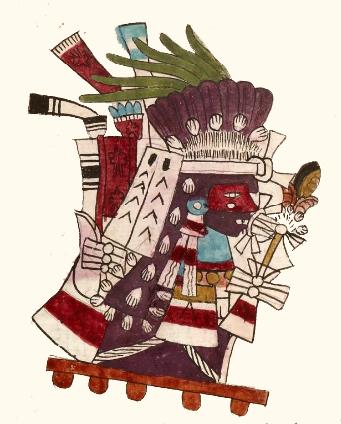miccailhuitl (TR2r)
This example of the pulque festival and month in the xiuhpohualli that is called miccailhuitl is included here as an example of iconography for use in comparisons with hieroglyphic writing. It provides examples of what we might call symbols associated with death and a deceased person (miquiztli and micqui), a carrying frame (perhaps a cacaxtli or a huacalli), quetzalli feathers, a flint knife (tecpatl), banners (panitl), and more.
Stephanie Wood
mic caylhujtl
miccailhuitl
ca. 1550–1563
Jeff Haskett-Wood
la muerte, festivales, veinte día, nombres de meses, calendarios, religión, feathers, plumas, flags, banderas, shrouds, sudarios, tecpatl

miccailhuitl, month name, https://nahuatl.wired-humanities.org/content/miccailhuitl
(nombre de un mes de veinte días relacionado con la muerte)
Stephanie Wood
Telleriano-Remensis Codex, folio 2 recto, MS Mexicain 385, Gallica digital collection, https://gallica.bnf.fr/ark:/12148/btv1b8458267s/f29.item.zoom
The non-commercial reuse of images from the Bibliothèque nationale de France is free as long as the user is in compliance with the legislation in force and provides the citation: “Source gallica.bnf.fr / Bibliothèque nationale de France” or “Source gallica.bnf.fr / BnF.”



